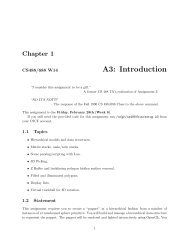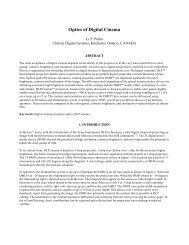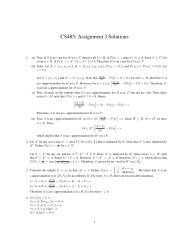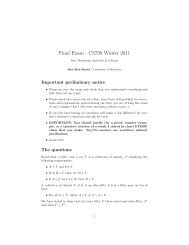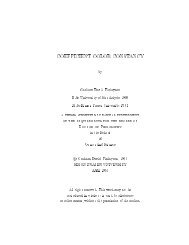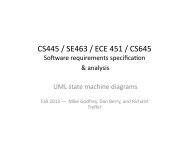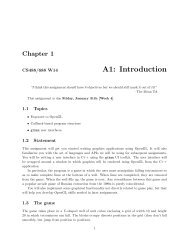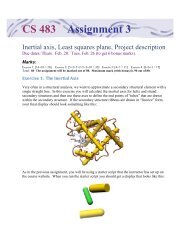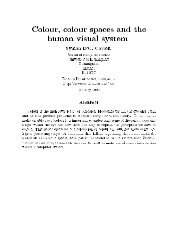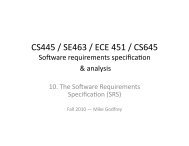Past Midterm and Exam Questions (PDF) - Student.cs.uwaterloo.ca ...
Past Midterm and Exam Questions (PDF) - Student.cs.uwaterloo.ca ...
Past Midterm and Exam Questions (PDF) - Student.cs.uwaterloo.ca ...
You also want an ePaper? Increase the reach of your titles
YUMPU automatically turns print PDFs into web optimized ePapers that Google loves.
CS488/688 Introduction to Computer Graphi<strong>cs</strong> 23<br />
Describe the ray tracing process discussed in the paragraph above on a ray (p, ⃗v) as it is traced<br />
in this scene. Assume that the transformed ray strikes the simple primitive at point q <strong>and</strong> that the<br />
primitive has normal ˆn at q, where both q <strong>and</strong> ˆn are specified relative to the modeling coordinates<br />
of the simple primitive.<br />
Be sure to note what geometric entities get transformed <strong>and</strong> what transformation they get<br />
transformed by, what ray is used in the object intersection <strong>ca</strong>lculation, <strong>and</strong> what geometric surface<br />
information is used in the actual shading <strong>ca</strong>lculation.<br />
9.7 Ray Tracing <strong>and</strong> Hierarchi<strong>ca</strong>l Transformations [Last Used: Winter 2000<br />
<strong>Midterm</strong>]<br />
Suppose you are given the following parameters for viewing a scene relative to a left h<strong>and</strong>ed world<br />
frame:<br />
View direction: (0, -3, 4)<br />
Up vector: (0, 1, 0)<br />
Eye point: (0, 10, -10)<br />
Field of view: 90 degrees<br />
a) Define a left h<strong>and</strong>ed orthonormal view frame with respect to the world frame. The z-axis should<br />
point in the view direction, the y-axis should be in the same plane as the view direction <strong>and</strong><br />
the up vector, <strong>and</strong> the origin should be at the eye point.<br />
b) Give a change of basis matrix from coordinates relative to the view frame to coordinates relative<br />
to the world frame.<br />
c) Suppose you are given the following DAG. Transformation matrices V, M, <strong>and</strong> L represent<br />
change of basis transformations from child space to parent space. We have found a ray-object<br />
intersection point <strong>and</strong> normal in model space <strong>and</strong> wish to perform a lighting <strong>ca</strong>lculation in<br />
light space. Indi<strong>ca</strong>te the required transformation to convert E V , P M <strong>and</strong> N M into light space<br />
(fill in the blanks below).<br />
World Space<br />
V M L<br />
View Space Model Space Light Space<br />
EV<br />
P M<br />
E<br />
=<br />
L<br />
EV<br />
N M<br />
P<br />
=<br />
L<br />
P M<br />
N =<br />
L<br />
N M<br />
?<br />
?<br />
?<br />
9.8 Hierarchi<strong>ca</strong>l Transformations [Last Used: Winter 2006 Final]<br />
Suppose you are given the following two-dimensional CSG scene hierarchy



